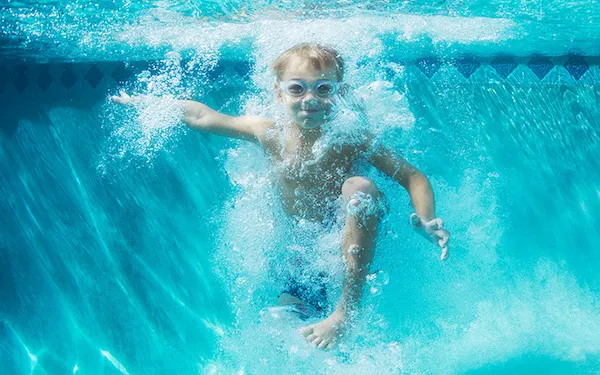Water safety tips
Don’t assume your child is safe even if they know how to swim. Here are tips to help families have good, safe fun around water.
As many as 91 million people in the United States swim recreationally and competitively. Swimming is a low-impact fitness activity and a great way to increase strength, endurance, and cardiovascular health.
Although swimming is generally considered a safe sport, the intense training and physical demands of swimming can lead to injuries. Swimming-related accidents can happen to both experienced and inexperienced swimmers.
Most swimming injuries are overuse injuries, caused by repetitive stress on the same area. Swimmers’ shoulders, knees, hips, and backs are susceptible to pain and inflamed tendons (tendinitis), particularly competitive swimmers with heavy training programs. Drowning is also a concern, particularly for young, inexperienced swimmers.
A competitive swimmer may take over a million strokes per year during training and competition. It’s no surprise that overtraining can lead to inflammation and swelling in the muscles and tendons that connect the shoulder blade (scapula) to the upper arm bone (humerus). Swimming can also cause shoulder instability, where the ball (humeral head) moves out of the socket (glenoid) of the shoulder, resulting in cartilage and ligament injury.
Water that remains in the ear after swimming can cause bacteria or fungus to grow. The result is swimmer’s ear (otitis externa), an infection of the outer ear canal.
The unique motion of the breaststroke kick may lead to knee injuries that involve the tendons and ligaments (breaststroker’s knee). Breaststrokers may also experience hip pain from inflammation of the hip tendons.
The area where the spine meets the pelvis can be injured by the dolphin kick — a technique in which the lower body moves like a whip to propel the swimmer forward underwater.
Warm up before swimming to stretch the muscles, get the blood flowing, and reduce the risk of injury. The warmup can include low-intensity aerobic exercises and slow, gentle stretches in which the athlete holds each stretch for 15 to 30 seconds.
Learn and practice good stroke technique. Whether you’re a competitive or recreational swimmer, swimming the wrong way can put extra stress on muscles and joints and lead to overuse injuries. Take lessons or follow your coach’s instructions.
Stay in shape with cross-training. Dry-land training that includes core strengthening and strengthening the muscles around the shoulder and upper back can reduce injury risk.
Keep your ears dry. Swim with a well-fitting swim cap and consider wearing ear plugs to keep water out of your ears. After swimming, use a towel to dry the outer ears. Tilt each side of your head toward the ground to allow water to drain out of the ear canals. If needed, talk to your doctor about ear-drying drops.
Swim in supervised areas, preferably with lifeguards present. Never swim alone in a pool, lake, pond, or ocean.

Don’t assume your child is safe even if they know how to swim. Here are tips to help families have good, safe fun around water.
As the largest and most experienced pediatric and young adult sports medicine practice in the country, the Sports Medicine Division at Boston Children's combines personalized care with innovative treatment for each athlete we treat.
Our Sports Medicine team consists of sports medicine physicians, orthopedic surgeons, physical therapists, podiatrists, athletic trainers, sports psychologists, dietitians, and many others who collaborate in every aspect of our patients’ care and their recovery.
The Hand and Orthopedic Upper Extremity Program provides comprehensive care for infants, children, adolescents, and young adults with a wide range of injuries of the hand, wrist, arm, elbow, and shoulder.
The Micheli Center for Sports Injury Prevention, part of the Sports Medicine Division, offers practical strategies that help young athletes reduce their risk of injury while enhancing their sports performance. Our rehabilitation and strength training programs help injured athletes return to play stronger and healthier.
Whether injury prevention or recovery is your goal, we have the skills and dedication to help you remain active in the sports you love.